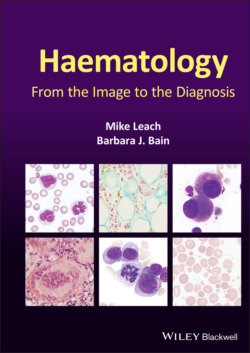Читать книгу Haematology - Barbara J. Bain, Irene Roberts - Страница 13
Оглавление4 Neutrophil morphology
The neutrophil has been a focus of attention for haematologists for many decades and this remains true today for many reasons. These phagocytic and bactericidal cells are a key player in innate immunity but have many other roles in systemic inflammation, cytokine signalling and tissue remodelling and repair. Quantitative and qualitative disorders of neutrophils can have serious consequences for the patient and, importantly, recognising the nature and existence of these abnormalities can be instrumental in diagnosis. Furthermore, we generate iatrogenic neutropenia when treating many haematological diseases, so a full appreciation of the importance of the neutrophil lies at the core of haematology practice. The patient history and examination will provide the foundation for clinical assessment but careful focused supporting laboratory examination is always key to generating a specific diagnosis. We are all familiar with the characteristics of the normal neutrophil but defining clear morphological abnormalities can be more challenging due to the nuances of normality, clinical circumstances and coexisting disease and its treatment. Neutrophil morphology can be informative in many different clinical situations. The blood film images above, from a woman with a myelodysplastic syndrome, show neutrophils displaying profound hypogranularity (all images ×100 objective); in addition, some cells show abnormal nuclear segmentation (extreme left, centre right). Furthermore, one cell (extreme right) shows an unusual location of the drumstick, which preferentially arises from the distal half of a terminal segment (extreme left) (Karni et al. 2001).
The images above show more examples of abnormal nuclear segmentation in MDS; in simplistic terms the neutrophil nucleus should show a ‘string of sausages’ type orientation of nuclear segments. Though not 100% specific, we would encourage you to use this idea as a basis of defining normality. Note the variety of abnormal segmentation in each image above and the particularly odd orientation of nuclear lobes in the image extreme right.
Further examples are illustrated above; note the mature but non‐lobated nucleus in the neutrophil extreme left. Attention to the abnormal nuclear morphology might be lost when the eye is drawn to the cytoplasmic hypogranularity but the nuclear features shown here are significant.
Importantly, changes in neutrophil morphology can be reactive in nature so the clinical circumstances should be accounted for at the time of the blood film report, if the latter is to be fully informative. The images above are all from the peripheral blood of a patient with overwhelming bacterial sepsis; note the neutrophil hyposegmentation, including non‐lobated neutrophils and pseudo‐Pelger forms, together with cytoplasmic vacuolation and toxic granulation. Compare the above with the inherited condition Pelger–Huët anomaly (see Theme 38).
Neutrophil hypersegmentation can also be a feature of dysplasia but more frequently is seen in vitamin B12 or folic acid deficiency (above left). Reactive neutrophilia is common in inflammatory, infective and neoplastic conditions. The left centre image above is from a patient with a reactive neutrophilia as a response to corticosteroid therapy for small cell lung carcinoma. The image right centre shows a toxic type neutrophilia resulting from granulocyte colony‐stimulating factor (G‐CSF) therapy and the image extreme right is from a patient with septicaemia with neutrophils demonstrating Döhle bodies. Furthermore, and relevant to other cases in this text, neutrophil morphology can inform the diagnosis of inherited disease (see Theme 90).
The left image (above) shows prominent neutrophil cytoplasmic vacuolation due to lipid accumulation in a patient with neutral lipid storage disease, a finding known as Jordans anomaly. The right image is from a patient with recurrent serious bacterial infections due to neutrophil‐specific granule deficiency (previously known as lactoferrin deficiency). The automated analyser misinterpreted these cells as monocytes as they have very similar light scatter characteristics.
Other neutrophil abnormalities that can be found in MDS include binucleated macropolycytes (above images, extreme left and centre left, both with marked hypogranularity) and other tetraploid cells (segmented macropolycytes, above centre right and extreme right).
Other features of MDS include detached nuclear fragments, ring nuclei and nuclei with irregular projections (all images above) and with chromatin condensed into dense blocks (all images above) (Bain 2015). The spectrum of neutrophil morphological abnormalities that are informative in the diagnosis of MDS and AML are well summarised by the International Working Group on Morphology of MDS (IWGM‐MDS) (Goasguen et al. 2013).
References
1 Bain BJ (2015) Blood Cells, 5th Edn. Wiley‐Blackwell, Oxford, pp. 99–107.
2 Goasguen JE, Bennett JM, Bain BJ, Brunning R, Vallespie MT, Tomonaga M et al.; International Working Group on Morphology of MDS (IWGM‐MDS) (2013) Proposal for refining the definition of dysgranulopoiesis in acute myeloid leukemia and myelodysplastic syndromes. Leuk Res, 38, 447–453.
3 Karni RJ, Wangh LJ and Sanchez JA (2001) Nonrandom location and orientation of the inactive X chromosome in human neutrophil nuclei. Chromosoma, 110, 267–274.
MCQ
1 A botryoid (‘grape‐like’) nucleus in a neutrophil can be a feature of:BurnsGranulocyte colony‐stimulating factor (G‐CSF) therapyHyperthermiaMyelodysplastic syndromeSepsisFor answers and discussion, see page 206.
